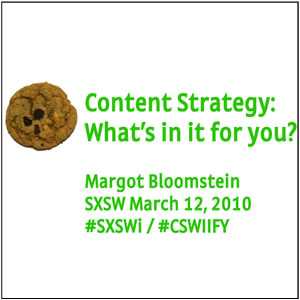(3/12/2010) Margot Bloomstein led her “Content Strategy: What’s in it for You?” session on this first day of SXSWi 2010 with a creative, tasty metaphor, using homemade cookies, not carrots, as bait for the audience. The woman knows how to make a first impression.
What she didn’t anticipate was the mass amounts of people in attendance, thus there wasn’t enough to go around. But no one seemed to mind. We were more intrigued by what she was presenting on the big screen.
Bloomstein works with some well-known clients, including Timberland, Philips, Staples and Harvard, presenting at the first Content Strategy Consortium last year in 2009. She states that the definition of this first summit was, “Planning for the creation aggregation, delivery and governance of useful, usable and appropriate content in an experience.”
The essence of this session was that the “planning” part saves loads of time wasted by “execution by fire” when you create a design or a comp to see if this is what your client had in mind.
Bloomstein starts with this question, posed to designers, “How do you visualize abstract concepts without concrete terms?”
One practice to arrive at the desired destination is to start with just words, because “Words are cheaper than comps.” I hear ya sister.
Using a web design project as an example, executing a message architecture exercise can enable you to translate the brand attributes into the project’s practical content and the needed design strategy. The result will be a richer user experience, higher level of user engagement, and then, a happy client.
Develop an exercise with the client to mutually create the common language to describe the brand for that website, one that presents a cohesive content and visual brand attributes. Remember index cards? Yeah. Dust those puppies off and begin by writing adjectives on index cards. Then go through the stack, indentifying terms and how they relate to who the client is, their competition, and how we would like to be seen—again, using their words. Start at the top and move down the ladder in terms of detail, starting at the home page and then to the tag line, and so on.
Not only will this help to avoid the Excedrin headache or Pepto Bismol stomach, you’ve got a practical strategy in place to save time and frustration for everyone involved. It also helps to do two key things for the client: stay on budget and schedule.
I say “hurray” to that.

The other observation I made during this session was that through this exercise the client can become personally engaged in the project in a way that substantially contributes to its success. Clients, for the most part, are not marketers, designers, developers, so they feel a bit exposed when they hire a contractor or agency to perform a service. Many times I’ve been brought into the project to “clean up” a mess left by a previous contractor, so the client is on the defense, and rightly so. I can see this exercise giving them some peace of mind as to the end result.
Moving on to the Information Architects and Project Managers, Bloomstein asks, “How do you plan for the future if you don’t know what you currently have, or what you need?” using a comparison of planning for a meal if you don’t know what you have in the kitchen.
Beyond the process of seeing what’s in the cupboards in terms of taking content inventory, she talks about doing a conduct quantitative and qualitative audit. Check for parity in length, consistency in structure, if the same parts of speech are used, along with what is current, appropriate and relevant. This enables you to enlist a useful gap qualitative analysis between the content that exists and the new message architecture, answering the questions of: What do we have? What do we need? Is the content doing its job?
The skills needed to perform this task do not overlap with Copywriting. And I expect clients will hit us up on this, especially those that have in-house copywriters, so be prepared.
Copywriting doesn’t answer the strategic questions mentioned above. Another key point made by Bloomfield is, internal resources lack an outside perspective. They are great for maintaining content, but having an outside perspective is a good thing. For one, we can more clearly see the benefits and then the features, because that’s the mindset of the target audience, “What’s in it for me?”
Content strategy can also be used within SEO and Social Media projects.
For SEO, using the message architecture exercise enables the tone to be set for the desired user experience, that is then translated to meta data. By planting the seeds early you have more room to target more specific keywords in line with the client’s brand versus highly popular and competitive keywords that just get the client’s website lost in crowd.
For social media, Bloomstein echoes what most social media consultants start with when working with a new client – stop talking about just you. We may say it a bit nicer than that, unless the client is someone from The Housewives of Beverly Hills reality show, but it all comes back to engagement and two-way conversations.
“’What do you want from us today?’” Bloomstein asks the crowd, rhetorically. “Good conversations demands good content strategy. That’s where you’re going to answer the question of ‘What do we want to communicate’ and ‘How can we do it?’ Content strategy can help you prioritize communication goals to ensure consistency even on Twitter.”
All of this comes back again to selling the specific line item of Content Strategy within a project bid, something the client isn’t expecting, yet being able to justify it with the ultimate selling points of saving them time and money.
There’s a dedicated website and book from Kristina Halvorson at:
http://contentstrategy.com/
Follow Margot Bloomstein – @mbloomstein – and the #contentstrategy conversation on Twitter. Her website is http://appropriateinc.com/.
UPDATE: View Bloomstein’s presentation SXSWi 2010 presentation –
http://www.slideshare.net/mbloomstein/content-strategy-whats-in-it-for-you-at-sxsw

